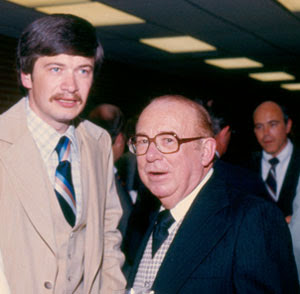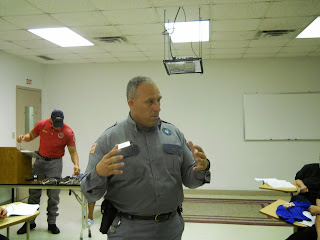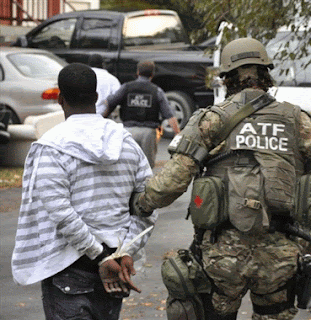
Dr. Jerry Dowling stands next to a portrait of founding Dean Dr. George Killinger, who hired him in 1972.
In the early days of the College of Criminal Justice, Dr. Jerry Dowling started “distance learning” -- driving his car to Dallas, San Antonio, Austin, Beaumont and Corpus Christi to help working police officers get a college education.
Now he has mastered distance learning on the computer, delivering his well-crafted classes to a diverse student body all over the state.
“We were doing distance learning but we did it by jumping in a car and going there,” quipped Dr. Dowling. “We had a large number of working police officers at that time, and we would run classes in back to back shifts, every Tuesday evening and Wednesday morning. That way, if they switched shifts, they could still finish the class.”
After more than four decades teaching at Sam Houston State University, Dr. Dowling will retire in May, leaving a legacy in policing and law enforcement, including textbooks, professional licensing and testing, and models for patrol allocations, as well as thousands of students who have excelled in the field.

Dr. Dowling with Dr. Killinger in 1977.Dr. Dowling joined the then Institute of Contemporary Corrections in 1972 after getting a law degree from The University of Tennessee and serving in the FBI in Dallas and Los Angeles. In Dallas, he was a special agent for general crime cases, most involving fugitives, and in Los Angeles, he was assigned to a unit dealing with domestic terrorism, including bombings and the Weatherman, a violent left wing organization that opposed the Vietnam War.
“I chased Bill Ayers (the Weatherman leader) all around, but I never caught him,” Dowling recalled.
When he and his wife decided to settle down and start a family, he looked for another less dangerous line of work. Through a friend from the FBI, he got a phone interview with Dr. George Killinger, the founding Director of the Institute, and was hired on the spot.

Dr. Dowling has been teaching at SHSU for 42 years.It was the 1970s and a new federal initiative, called the Law Enforcement Education Program (LEEP), provided grants to working officers to obtain a higher education. During the early days of criminal justice programs, Dr. Dowling taught undergraduate and graduate classes simultaneously in the field, even attracted police chiefs from Dallas and Port Arthur to his classes.
“It was a good example of how we were able to adapt the delivery of education to the needs of our clients,” Dr. Dowling said. “We were building relationships and our reputation in the field.”
Over the years, Dr. Dowling has continued to adapt his instruction, annually tweaking his lessons to meet the needs of the changing population. When he first started teaching, the profession was dominated by white males. Now many women and minorities have joined the field.

Dr. Dowling reflects on changes in criminal justice.“It took three or four years on campus before there were female students in my criminal justice classes,” Dr. Dowling said. “The really big change when I walk down the halls now is the number of female and minority students. It is a reflection of the broader acceptance of diversity.”
During his tenure at Sam Houston State University, Dr. Dowling was instrumental in licensing and promotional exams for police officers. Along with Dr. Larry Hoover, he wrote the first licensing exam for peace officers in Texas and Illinois and developed curricula for basic police training in Texas, Illinois, New York and Maine. He also is responsible for the training used for jailers at the Texas Commission on Law Enforcement and for school resource officers in Kentucky. Finally, he worked at the Bill Blackwood Law Enforcement Management Institute of Texas as an instructor, providing classes on legal liability and labor relations for professionals in the field.
Dowling was also an avid writer, penning numerous books and dozens of article in his specialties of criminal law, pre-trial criminal procedures, and criminal investigation. He recently completed the 2nd Edition of Texas Criminal Law: Principles and Practices, due out later this year

Dowling was among five SHSU faculty to hit the 40 year milestone.Over the years, he molded many leaders in the criminal justice field and remains friends with them to this day. Take Gerry Ramker, Deputy Director of the Bureau of Justice Statistics. In the early days of computers, Ramker worked for Dr. Dowling, hauling boxes of punch cards to the mainframe across campus. Now Ramker is in charge of nationwide criminal justice databases for the Department of Justice.
Another student he fondly remembers is Larry Zacharias, the former Richardson Police Chief who serves as Chief of Police for the University of Texas at Dallas. During his college days, Zacharias was “long haired and bearded” who he hired to paint his house. Now, he leads police agencies.

Dr. Dowling reflects on the faculty and students he has known over the years.“You remember the people – the people you worked with and the relationships you built,” said Dr. Dowling. “You remember the students – the really good ones and the really bad ones. Some have become friends and you keep up with them. I was always pleased about that. You like to think you made a difference and helped them in the professional life and in the personal life to be a good human being.”
Dr. Dowling said he is leaving the College in good hands, with the up-and-coming crop of new professors who have joined the program.
“When I look around the College at the newer facility, they have different interests, but they share the same passions for the student. I feel good about these folks and I can walk about the door without any guilt.”
In his retirement, Dr. Dowling plans to continue teaching online courses.
“I think of retirement as working for yourself and what you want to do,” said Dr. Dowling.


























 Dr. Todd Armstrong studies the links between genes and crime.
Dr. Todd Armstrong studies the links between genes and crime. “These findings indicate that gene-by-environment interactions are important for understanding variation in crime amongst populations with high base rates of criminal activity,” said Dr. Todd Armstrong, the principal investigator of the study.
“These findings indicate that gene-by-environment interactions are important for understanding variation in crime amongst populations with high base rates of criminal activity,” said Dr. Todd Armstrong, the principal investigator of the study.  “No one has done this type of research with an incarcerated sample in North America,” said Armstrong. “It can help us understand the context and processes that link genes with criminal behavior and provide an avenue for understanding individual variation in the tendency to engage in crime.”
“No one has done this type of research with an incarcerated sample in North America,” said Armstrong. “It can help us understand the context and processes that link genes with criminal behavior and provide an avenue for understanding individual variation in the tendency to engage in crime.”


.jpg)


 The study was based on a survey of more than 3,500 students from ages 12-18 from across the nation. The students were asked questions about bullying and cyberbullying, including whether hurtful information about them were posted on the internet or if they had been insulted or threated by email, instant messaging, text messaging or online gaming program. The students were also asked if they had been excluded from online friends or buddy lists.
The study was based on a survey of more than 3,500 students from ages 12-18 from across the nation. The students were asked questions about bullying and cyberbullying, including whether hurtful information about them were posted on the internet or if they had been insulted or threated by email, instant messaging, text messaging or online gaming program. The students were also asked if they had been excluded from online friends or buddy lists.

 “Wherever there were animals, there was someone hunting them,” said Teeler.
“Wherever there were animals, there was someone hunting them,” said Teeler.

















 With the rash of armed robberies of cell phone stores and pawn shops in the Houston area, ATF Special Agent Alex Johny is assigned to a task force to catch the criminals behind those serial attacks.
With the rash of armed robberies of cell phone stores and pawn shops in the Houston area, ATF Special Agent Alex Johny is assigned to a task force to catch the criminals behind those serial attacks. Johny investigates cases by doing his homework, trying to identify perpetrators by working with confidential informants, street names or nicknames.Once he identifies a suspect, he has to verify that, in fact, it is illegal for that individual to possess a gun. For example, some offenders charged with felony cases plead out to lesser crimes that do not restrict gun ownership.
Johny investigates cases by doing his homework, trying to identify perpetrators by working with confidential informants, street names or nicknames.Once he identifies a suspect, he has to verify that, in fact, it is illegal for that individual to possess a gun. For example, some offenders charged with felony cases plead out to lesser crimes that do not restrict gun ownership. In addition to catching offenders, ATF agents are responsible for preparing the case for prosecution as well as the administrative duties of forfeiting and destroying weapons. If a gun was stolen, they are also charged with getting it back to the rightful owner.
In addition to catching offenders, ATF agents are responsible for preparing the case for prosecution as well as the administrative duties of forfeiting and destroying weapons. If a gun was stolen, they are also charged with getting it back to the rightful owner. While Johny concentrates on guns, the mission of the ATF goes well beyond firearms. The federal agency is charged with protecting communities from violent criminals and organizations involved in the use and trafficking of illegal fireworks; the illegal use and storage of explosives; acts of arson, bombing or domestic terrorism; and the illegal diversion of alcohol and tobacco products.
While Johny concentrates on guns, the mission of the ATF goes well beyond firearms. The federal agency is charged with protecting communities from violent criminals and organizations involved in the use and trafficking of illegal fireworks; the illegal use and storage of explosives; acts of arson, bombing or domestic terrorism; and the illegal diversion of alcohol and tobacco products.